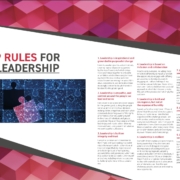Just In Time Hiring, ‘Covering’ and the Engagement Crisis
I’ve talked at length in previous blogs and articles about employee engagement, but now I’m going to address a political hot potato – that thing that many people in organisations all know, all whisper about around the water cooler, but won’t say out loud, and that is the staffing model. How many of us have been in situations where our colleagues have gone off on long holidays or unfortunately have gone off sick for a long period of time, or fortunately have had children? What happens with the rest of us? Almost always, our organisation asks us to pick up the slack. So for a long period of time we’re not just trying to fulfil our roles, but we’re trying to fulfil someone else’s role as well. But do we receive both titles? No. Do we receive two salaries? No. Are we rewarded in any way by our organisations? Typically not. In fact, in many ways we’re often punished. What do I mean by that? Well, think about what happens during one’s annual review. Your boss or HR might say, ‘Well look, you didn’t achieve these objectives,’ and you’re thinking, ‘Yeah, I didn’t fully achieve those objectives because I was trying to achieve those objectives and someone else’s objectives while trying not to keel over from exhaustion!’
So our organisations might philosophically say we have just the right number of people to fulfil all the roles required. In reality, architecturally our organisations are chronically understaffed, and that creates an enormous engagement problem.
Think about what happens when organisations downsize and they tell teams, ‘Okay, yes, we know you had to do x amount of work with six people but now you have to do x amount of work with two people, but don’t worry’, the organisation says, ‘After six months we’ll revisit. This is just temporary.’ And we all know what happens: Two years later you look back and you think, ‘Huh! We’re still in exactly the same position. We’re all working umpteen hours a day, and this was all supposed to be temporary!’ Organisations sometimes claim: ‘We have just in time hiring. As soon as we see a gap we will hire.’ I say that’s almost always nonsense. Organisations typically do not do that. They tacitly expect their people to pick up the slack. And if they are going to do that, then at least be honest with employees. When you do put them under that stress of having to work two or three jobs for the same title for the same salary for long stretches, then, even better than simply being honest about it, reward them for it and watch what will happen to your employee engagement when you combine transparency with recognition.
Adam Kingl, www.adamkingl.com, is the author of Next Generation Leadership and Sparking Success. He is also an educator, adviser and keynote speaker.








